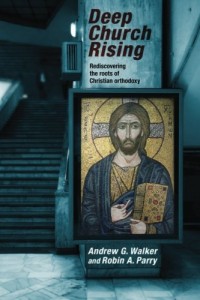
Andrew G. Walker and Robin A. Parry. Deep Church Rising: Rediscovering the roots of Christian orthodoxy. London: SPCK, 2014
Walker and Parry begin with the same sociological realities that Davie carefully charts, but rather than simply making sociological observations about them, offer a theological critique and response. In their view, Christianity has historically faced three great schisms. The first great schism was the divide between the Western and Eastern churches, which began with the controversy over the addition of filioque (“and the Son”) to the Nicene Creed. The second occurred with the Reformation and the third is underway in the West at present.
They describe this third schism as follows:
Growing numbers of people want to remain Christian in some way, despite the fact that they can no longer assent to many of the doctrines of the creeds, believe in the Bible as a broadly reliable record of historical narratives, or find credible the possibility of miracles in either the past (including the virgin birth and resurrection of Christ) or the present (p.9)
Walker and Parry respond by drawing on the notion of “Deep Church,” which they define as deep in both a solid and a liquid way, having both a historical and an existential reality. The solid depths of Deep Church are the bedrock of faith, built on Christ himself. The liquid depths are the flowing streams of the Spirit. The historical reality rests on God’s self-revelation to the world of himself in the person of his Son and on the Son’s institution of the Church. We must avail ourselves of all the historical resources at our disposal if we are to adequately build Deep Church for the twenty-first century. But at the same time we must have existential, not just historical or intellectual, experience of God; we must be part of the Church constituted by the Spirit, experiencing the presence and indwelling of the Spirit. Rooted in history, the Church should seek spiritual experiences in the present.
Walker and Parry outline the roots of the third schism through a clear and concise overview of the rise of modernity and postmodernity. They are realistic about the present situation: Christendom has ended and the model of church that presumes Christendom is therefore no longer useful. While this may be lamented, they also believe it to be an opportunity for “a fresh improvisation of the faith that is both deeply rooted in Scripture and tradition but also alive to the worlds we now inhabit” (p.28). Deep Church Rising begins this process.
The issues are discussed in seven chapters which tackle issues such as the relationship with Scripture and Tradition, the nature of Orthodoxia (Right Believing and Right Worship) and Orthopraxia (Right Practice), the need for catechesis and Deep Church as a Eucharistic Community. Walker and Parry’s arguments are primarily directed towards the evangelical and charismatic wings of the church. They argue for Christians to establish deep roots in their history, to avoid becoming like orphans bereft of family history. They understand the creeds as “national borders” defining Christian territory and argue in favour of the historic understandings of the Christian faith. They challenge consumerist approaches to worship and any form of passive engagement with church services. They suggest a cruciform approach to ethics, argue for the value of catechesis and the significance of the Eucharist. They are strong advocates of recognition of the real presence of Christ in the Eucharist, whilst recognizing the diversity of opinion “from pious agnosticism to transubstantiation to Luther to Calvin” (p.155).
Deep Church Rising is a stimulating and challenging wake-up call to the Church to remember rightly, to be rooted in tradition but engaged in the present, to remain faithful to Jesus but alive to the present. Where it perhaps falls down is in the lack of specific examples of what the Deep Church response to the present issues facing the church might be. Debates about the environment, sexuality and the place of women in church all hinge on the relationship between the historic teaching of the church and its present expression. Some more moves from theory to practice would have strengthened an already strong book and given specific insights into how Walker and Parry envisage Deep Church engaging with the complex reality of twenty-first century Britain. When I finished reading, I was still not entirely clear as to what constitutes the “third schism” and what constitutes “a fresh improvisation of the faith.” Perhaps Walker and Parry’s aim was simply to get me to think harder about these questions. In this they succeeded, and for this their book is to be warmly commended to all thinking Christians. But a slightly clearer idea of their own views might have helped me begin to see my way through the fog.
This book review was originally produced for Anvil Journal. The Journal is currently transitioning to a new partnership with CMS. During this phase, book reviews are being published by Fulcrum.
Revd Dr Tom Wilson is vicar of two churches in the centre of Gloucester, a urban and diverse part of an otherwise largely rural county. He is also Diocesan inter-faith advisor and reviews editor for Anvil, an evangelical journal of theology and mission (www.anviljournal.org). He is married with one child and another on the way. In his spare time he likes to read, run or go for a walk in the mountains.
